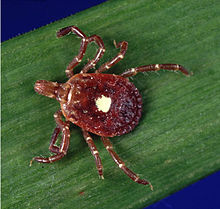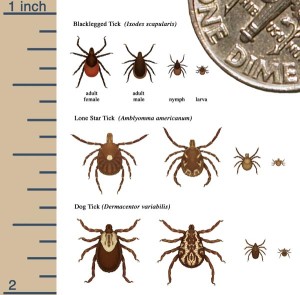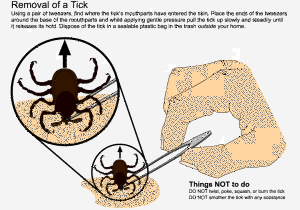I’ve heard a rumour that Spring is lurking just around the corner. Boy, do we deserve it after the ice and snow we’ve endured this Winter! Soon, we’ll be headed into the easy-breezy days that each and every one of us, including our special four-legged kids, enjoy. It sounds nothing short of pastoral; a good romp in fresh green grass, followed by an extended bask in warm sunshine. It also sounds dangerous. How could such a pleasant time be dangerous, you might ask? I’ll sum it up in a single word, TICKS. Yes, friends, Springtime is when those creepy-crawlies start to emerge from their hiding places in damp leaf piles, broken down wood stores and any number of other dark and dank habitats where they’ve over-wintered, and when they come out, they sure are hungry! They emerge in search of two things, blood from host animals and a mate to help them reproduce.
So, what about these arthropods? What do we need to know to help us keep our pets safe from their nasty bite? First, ticks are considered true parasites, because they provide no benefit to their hosts. They are widely varied, as many as 850 different sub-species exist, and they feed on every class of vertebrate, land-dwelling animal. Second, they can live for extended periods of time without feeding, but are set and ready to go as soon as a host is found. Some ticks lay dormant for as long as twenty years and most ticks have a life span of at least one year. And third, they can be vectors for the spread of significant and life-threatening illnesses to your pet and you!
Every region has certain species that are more common, although ticks can travel on hosts and spread to different areas of the country. In our region, there are three ticks that are most frequently seen:
![The American [Brown] Dog Tick](http://dogbonemarket.com/wp-content/uploads/2014/03/Unknown-copy.jpeg)



Interesting, right? Maybe, if you’re a veterinarian or an entomologist, but in the long run the most important thing when you find one of these suckers on your pet is what to do next? Hopefully, Fido doesn’t emerge from his first forage in the woods looking like this:

If he does, you will need to seek the help of your veterinarian to remove the ticks and more than likely treat for local skin infection as well as potential diseases such as Rocky Mountain Spotted Fever or Lyme’s Disease. We’ll address those diseases and several others in part two of this series! Thankfully, it is more common to find a single, or few ticks on your dog or cat. I’ve heard all sorts of remedies for tick removal, everything from lighting the tick with a match to soaking it alcohol. While I’m a believer in a lot of grandma’s remedies, none of these are recommended. The best and safest way to remove the tick is pictured below:
What’s better than removing ticks from your fur-kid? Prevention!
One of the first steps to take is to eliminate the tick habitat as best you can. Make sure disused wood piles are broken down, leaves and detritus are cleaned from places your pet might like to rest, and moist mulch beds are turned over. In areas that are heavily infested, some chemical options for control are also available. Make sure they are pet-safe and consult the manufacturer or your veterinarian before applying anything in areas where your pet may have access.
Additionally, and perhaps most important for your pet, is your access to many, many products on the market that are both safe and effective in controlling tick infestations. We are all familiar with the spot-on varieties. Caution does need to be used with some of these treatments if they are used on or in a household with cats. PLEASE READ AND FOLLOW ALL SAFETY PRECAUTIONS on your chosen product. There is a potential for life-threatening complications if a canine version is used on a cat, or if a *canine only* product is used even in the presence of cats. Also, there are some medications that would not be recommended if your pet has certain medical conditions. Your veterinarian should be used as a resource for what will be safest and most effective means of control in your pet household. Please consult them even if you plan on purchasing an over the counter preventative! New to the market this year for dogs is an oral flea and TICK medication that is given once monthly, similar to heartworm preventative products. It is showing a lot of potential for pets who have challenges with the spot-on products. Fortunately, there is an easier solution to prevention now. Again, please consult your veterinarian for information about this or any parasite control product!
So, prevention is great, but what happens if your pet gets a tick and it wasn’t removed in time to prevent disease transmission? Stay tuned for Part Two- Tick-borne disease…

